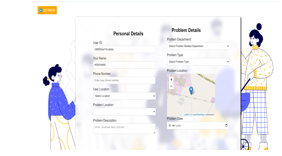Ijraset Journal For Research in Applied Science and Engineering Technology
- Home / Ijraset
- On This Page
- Abstract
- Introduction
- Conclusion
- References
- Copyright
Citizen Connect: Engaging Communities for Change
Authors: Vijaya Bhaskar V, Mithhull Balaji, Krishnan M, Mohanapriya K
DOI Link: https://doi.org/10.22214/ijraset.2024.59291
Certificate: View Certificate
Abstract
In an era of unprecedented connectivity and technological advancement, the concept of citizen engagement has taken on new dimensions. \"Citizen Connect: Engaging Communities for Change\" explores the intersection of technology, community participation, and social change. This paper delves into the significance of empowering citizens to actively participate in decision-making processes, fostering community cohesion, and driving positive transformations at various levels of society. Through case studies, theoretical frameworks, and practical examples, it elucidates the importance of leveraging digital platforms, social media, and grassroots initiatives to facilitate meaningful dialogue, collaboration, and action among citizens. By examining successful models of citizen engagement and highlighting emerging trends, this paper aims to inspire and inform stakeholders interested in harnessing the collective power of communities for sustainable development and inclusive governance.
Introduction
I. INTRODUCTION
Definition of citizen engagement. Importance of community participation in effecting change. Evolution of technology and its impact on citizen engagement. [A]. Contextualizing Citizen Engagement [1]. In contemporary society, the concept of citizen engagement stands as a cornerstone for fostering inclusive governance and effecting meaningful societal change. At its core, citizen engagement encapsulates the active involvement of individuals in decision-making processes, policy formulation, and community initiatives.[2]. Over the years, the landscape of citizen engagement has evolved significantly, propelled by advancements in technology, shifting socio-political dynamics, and a growing recognition of the value of community-driven approaches to addressing complex challenges.[3]."Citizen Connect: Engaging Communities for Change" serves as a platform to delve into the multifaceted nature of citizen engagement, exploring its theoretical underpinnings, practical applications, and transformative potential. [B]. Rationale for the Study. [1]. The rationale behind this study lies in the recognition of the pivotal role that citizen engagement plays in driving positive change across various spheres of society. By empowering individuals to actively participate in decision-making processes and community initiatives, citizen engagement not only fosters a sense of ownership and belonging but also ensures that policies and interventions are reflective of diverse perspectives and needs. [2]. Moreover, in an increasingly interconnected world where information flows freely and boundaries between physical and digital spaces blur, the harnessing of technology has emerged as a potent tool for amplifying citizen voices, facilitating collaboration, and catalyzing collective action. [3]. Thus, this study seeks to explore how the convergence of citizen engagement and technology can serve as a catalyst for community empowerment, social cohesion, and sustainable development.
[C]. Objectives of the Study: [1]. To provide a comprehensive overview of the theoretical frameworks underpinning citizen engagement, including seminal models such as Arnstein's ladder of citizen participation and theories of participatory democracy. [2]. To examine the role of digital platforms in facilitating citizen engagement, encompassing social media, crowdsourcing platforms, and open data initiatives, and their impact on enhancing transparency, accountability, and civic participation. [3]. To showcase case studies highlighting successful examples of citizen-led initiatives, ranging from participatory budgeting in urban settings to grassroots development projects in rural areas, thereby elucidating best practices and lessons learned. [4]. To identify challenges and opportunities inherent in fostering citizen engagement, including addressing the digital divide, ensuring inclusivity, and building trust between citizens and governmental institutions. [5]. To explore emerging trends at the intersection of citizen engagement and technology, such as the adoption of blockchain, virtual reality, and artificial intelligence, and their potential implications for shaping the future of community-driven governance and social change. [D].
Significance of the Study: [1]. This study holds significant implications for policymakers, community leaders, activists, and researchers alike, providing insights and actionable strategies for fostering citizen engagement and driving positive change. [2]. By highlighting the transformative potential of citizen-led initiatives and the role of technology in amplifying citizen voices, this study aims to inspire stakeholders to embrace innovative approaches to governance, community development, and social activism. [3]. Ultimately, by fostering greater citizen participation, inclusivity, and collaboration, this study seeks to contribute to the creation of more resilient, equitable, and sustainable communities, wherein every voice is heard, valued, and empowered to effect change.

II. THEORETICAL FRAMEWORKS
[A]. Arnstein's ladder of citizen participation: [1]. Arnstein's ladder, proposed by Sherry Arnstein in 1969, provides a conceptual framework for understanding the varying degrees of citizen participation in decision-making processes. The ladder consists of rungs ranging from "non-participation" to "citizen control," reflecting the spectrum of power dynamics between citizens and authorities. [2]. This framework underscores the importance of moving beyond tokenistic forms of participation, wherein citizens are merely informed or consulted, towards genuine empowerment and collaboration, wherein citizens have a substantive influence on decisions that affect their lives.
[3]. By contextualizing citizen engagement within Arnstein's ladder, stakeholders can evaluate the depth and quality of citizen participation in various initiatives, thereby informing strategies to enhance inclusivity, transparency, and democratic governance. Participatory democracy theories. Social capital and community development. [B]. Theories of Participatory Democracy. [1]. Participatory democracy theories advocate for the active involvement of citizens in the decision-making processes of government and other institutions. Rooted in principles of direct democracy, deliberative democracy, and grassroots activism, these theories emphasize the importance of decentralization, deliberation, and civic engagement in shaping public policies and practices. [2]. Scholars such as Carole Pateman, Jürgen Habermas, and Benjamin Barber have contributed to the discourse on participatory democracy, offering insights into the mechanisms through which citizens can exercise agency, voice their concerns, and hold authorities accountable. [3]. By drawing upon participatory democracy theories, policymakers and community leaders can design institutional frameworks and mechanisms that facilitate meaningful citizen engagement, foster deliberative dialogue, and promote collective decision-making processes. [C]. Social Capital and Its Role in Community Development. [1]. Social capital, coined by sociologist Pierre Bourdieu and further developed by scholars like Robert Putnam, refers to the networks, norms, and trust that enable cooperation and collective action within communities. [2]. This theoretical framework posits that communities with high levels of social capital are better equipped to address common challenges, mobilize resources, and foster civic engagement. Conversely, low levels of social capital can impede community cohesion, inhibit collective action, and exacerbate social inequalities. [3]. Understanding the dynamics of social capital provides insights into the mechanisms through which communities can cultivate trust, solidarity, and reciprocity, thereby enhancing their capacity for self-governance, problem-solving, and sustainable development. [D]. Intersectionality and Citizen Engagement: [1]. Intersectionality, a concept developed by Kimberlé Crenshaw, acknowledges that individuals occupy multiple social identities and experience intersecting forms of oppression and privilege. [2]. Incorporating an intersectional lens into discussions of citizen engagement highlights the importance of recognizing and addressing the diverse needs, perspectives, and experiences of marginalized communities.
[3]. By centering intersectionality in citizen engagement efforts, stakeholders can ensure that initiatives are inclusive, equitable, and responsive to the intersecting dimensions of identity, thereby advancing social justice and fostering solidarity within diverse communities.
III. DIGITAL PLATFORMS FOR CITIZEN ENGAGEMENT
Utilization of social media for community mobilization. Crowdsourcing platforms for collaborative problem-solving. Open data initiatives enhancing transparency and accountability. [A]. Social Media as a Tool for Community Mobilization. [1]. Social media platforms such as Facebook, Twitter, and Instagram have emerged as powerful tools for mobilizing communities, amplifying voices, and disseminating information. [2]. These platforms facilitate real-time communication and networking among citizens, enabling the rapid spread of ideas, campaigns, and calls to action. [3]. By harnessing the viral nature of social media, grassroots movements and advocacy campaigns can reach a wide audience, garner support, and catalyze collective action on pressing social issues. [B]. Crowdsourcing Platforms for Collaborative Problem-Solving. [1]. Crowdsourcing platforms, such as OpenIDEO and Crowdsourced Democracy, provide avenues for citizens to contribute ideas, expertise, and resources to address complex challenges. [2]. These platforms leverage the collective intelligence of diverse stakeholders, tapping into distributed knowledge and creativity to generate innovative solutions. [3]. Through crowdsourcing, communities can harness the power of collective problem-solving, co-create solutions, and foster a sense of ownership and investment in addressing shared concerns. [C]. Open Data Initiatives for Transparency and Accountability: [1]. Open data initiatives involve the proactive release of government data and information in accessible, machine-readable formats, enabling citizens to scrutinize, analyze, and utilize public information. [2]. By making data openly available, governments enhance transparency, accountability, and civic participation, enabling citizens to hold authorities accountable and make informed decisions. [3]. Open data initiatives also empower citizens, researchers, and civil society organizations to identify patterns, trends, and disparities, thereby informing evidence-based advocacy, policy formulation, and resource allocation decisions.
[D]. Online Engagement Platforms for Deliberative Democracy: [1]. Online engagement platforms, such as Citizen Lab and Your Priorities, facilitate deliberative dialogue and decision-making processes among citizens and policymakers. [2]. These platforms provide structured spaces for citizens to deliberate on policy proposals, prioritize initiatives, and co-create solutions in collaboration with government officials. [3]. By fostering inclusive and deliberative forms of engagement, online platforms contribute to the democratization of decision-making processes, bridging the gap between citizens and authorities and enhancing the legitimacy and effectiveness of governance structures.

IV. CASE STUDIES
Participatory budgeting initiatives in urban settings. Impact of online petition platforms on policy-formulation. Community-driven development projects in rural areas. [A]. Participatory Budgeting Initiatives in Cities: [1]. Participatory budgeting initiatives, such as those implemented in Porto Alegre, Brazil, and New York City, empower citizens to directly decide how public funds are allocated within their communities. [2]. These initiatives involve a deliberative process wherein residents propose, discuss, and prioritize projects, which are then voted on by the community. [3]. Case studies have demonstrated the effectiveness of participatory budgeting in enhancing transparency, accountability, and citizen satisfaction with public spending decisions, leading to improved service delivery and community development outcomes. [B]. Online Petition Platforms and Their Impact on Policy Change. [1]. Online petition platforms, such as Change.org and Avaaz, have emerged as powerful tools for mobilizing public support and advocating for policy change. [2]. Case studies, including the successful campaigns to ban single-use plastic bags in various cities and to advocate for climate action policies, highlight the ability of online petitions to raise awareness, mobilize grassroots support, and influence decision-makers. [3]. These platforms democratize the advocacy process, enabling individuals and grassroots organizations to amplify their voices, build coalitions, and hold policymakers accountable to public opinion. [C]. Community-Driven Development Projects in Rural Areas: [1]. Community-driven development projects, such as those facilitated by organizations like the World Bank's Community-Driven Development Program, empower local communities to identify, prioritize, and implement development projects tailored to their needs. [2].
Case studies from countries like Indonesia and Nepal demonstrate how participatory approaches to development, which engage communities in project planning, implementation, and monitoring, can lead to more sustainable and equitable outcomes. [3]. By fostering ownership, social cohesion, and capacity-building at the grassroots level, community-driven development projects contribute to poverty reduction, inclusive growth, and resilience building in rural communities. [D]. Civic Tech Platforms for Democratic Innovation: [1]. Civic tech platforms, such as MySociety's FixMyStreet and SeeClickFix, enable citizens to report and track issues in their neighborhoods, ranging from potholes and graffiti to environmental hazards. [2]. Case studies have shown how these platforms facilitate direct communication between citizens and local government authorities, leading to more responsive and accountable service delivery. [3]. By harnessing the power of citizen-generated data and digital technologies, civic tech platforms contribute to the democratization of urban governance, enhancing public participation, transparency, and efficiency in local decision-making processes.
V. CHALLENGES AND OPPORTUNITIES
Addressing the digital divide for inclusive engagement. Ensuring transparency and accountability in citizen-led endeavors. Fostering trust between citizens and governmental institutions. [A]. Digital Divide and Inclusivity Concerns: [1]. The digital divide persists as a significant challenge, with marginalized communities facing barriers to accessing and utilizing digital platforms for citizen engagement. [2]. Addressing disparities in internet access, digital literacy, and technological infrastructure is crucial for ensuring that citizen engagement efforts are inclusive and equitable. [3]. Opportunities lie in leveraging community-based initiatives, public-private partnerships, and innovative technologies to bridge the digital divide and empower underserved populations to participate in decision-making processes. [B]. Ensuring Transparency and Accountability in Citizen-Led Initiatives: [1]. Maintaining transparency and accountability in citizen-led initiatives poses challenges related to data integrity, privacy protection, and the verifiability of outcomes. [2]. Establishing robust mechanisms for data governance, verification, and auditability is essential for building trust among stakeholders and ensuring the legitimacy of citizen-driven initiatives. [3]. Opportunities exist for adopting blockchain technology, decentralized governance models, and participatory monitoring mechanisms to enhance transparency, accountability, and trustworthiness in citizen-led initiatives. [C]. Building Trust Between Citizens and Governmental Institutions: [1]. Distrust and skepticism towards governmental institutions can hinder citizen engagement efforts, undermining collaboration and collective action. [2]. Cultivating trust requires fostering open communication, responsive governance, and meaningful dialogue between citizens and authorities. [3]. Opportunities lie in embracing principles of open government, participatory decision-making, and co-creation of policies and services, thereby bridging the gap between citizens and government institutions and fostering a culture of collaboration and mutual respect. [D]. Overcoming Technological Barriers and Digital Exclusion: [1]. Technological barriers, such as limited access to digital infrastructure, outdated software, and cybersecurity threats, can impede effective citizen engagement efforts. [2]. Ensuring the accessibility, usability, and security of digital platforms is essential for overcoming technological barriers and promoting inclusive participation. [3]. Opportunities exist for investing in digital literacy programs, capacity-building initiatives, and user-friendly technology solutions tailored to the needs of diverse communities, thereby empowering citizens to fully participate in digital democracy.

VI. BEST PRACTICES AND LESSONS LEARNED
Importance of stakeholder engagement and collaboration. Flexibility and adaptability in response to evolving community needs. Sustainability of citizen-driven initiatives through long-term planning. [A]. Importance of Stakeholder Engagement and Collaboration: [1]. Effective stakeholder engagement, involving government agencies, civil society organizations, community leaders, and citizens, is critical for fostering inclusive and sustainable citizen engagement initiatives. [2]. Collaborative decision-making processes that prioritize diversity, equity, and inclusion enable stakeholders to contribute their unique perspectives, expertise, and resources, leading to more informed and equitable outcomes. [3]. Establishing mechanisms for ongoing communication, feedback, and dialogue fosters trust, strengthens partnerships, and ensures that initiatives are responsive to evolving community needs and priorities. [B]. Flexibility and Adaptability in Response to Changing Community Needs. [1]. Flexibility and adaptability are key attributes of successful citizen engagement initiatives, particularly in dynamic and rapidly changing contexts. [2]. By remaining responsive to emerging challenges, opportunities, and feedback from stakeholders, initiatives can adjust strategies, pivot priorities, and reallocate resources to maximize impact and relevance. [3]. Iterative approaches to planning and implementation, characterized by continuous learning, experimentation, and feedback loops, enable stakeholders to refine strategies, address gaps, and scale successful interventions over time. [C]. Sustainability of Citizen-Driven Initiatives through Long-Term Planning: [1]. Long-term sustainability hinges on strategic planning, capacity-building, and institutionalization of citizen engagement processes within government structures and community institutions. [2]. Investing in the development of local leadership, institutional mechanisms, and financial resources ensures the continuity and resilience of citizen-driven initiatives beyond short-term project cycles. [D]. Leveraging Technology for Continuous Improvement and Innovation: [1]. Technology plays a pivotal role in enhancing the effectiveness, efficiency, and scalability of citizen engagement initiatives. [2]. Embracing emerging technologies, such as artificial intelligence, machine learning, and data analytics, enables stakeholders to analyze citizen feedback, identify trends, and tailor interventions to meet evolving needs.

Conclusion
Recapitulation of key findings and insights. Call to action for fostering citizen engagement on local, national, and global scales. Prospects for leveraging technology to empower communities for positive change. [A]. Recapitulation of Key Findings and Insights: [1]. Throughout this paper, we have explored the multifaceted nature of citizen engagement and its role in fostering inclusive governance, community empowerment, and social change. [2]. By examining theoretical frameworks, case studies, and emerging trends, we have underscored the significance of leveraging technology, fostering collaboration, and addressing challenges to realize the full potential of citizen-driven initiatives. [B]. Call to Action for Fostering Citizen Engagement: [1]. As we look to the future, it is imperative for stakeholders across sectors to prioritize and invest in citizen engagement as a cornerstone of democratic governance and sustainable development. [2]. Governments, civil society organizations, and community leaders must work collaboratively to create enabling environments for meaningful citizen participation, ensuring that policies and interventions are responsive to diverse needs and voices. [C]. Prospects for Leveraging Technology to Empower Communities for Positive Change: [1]. Technology continues to evolve and offer new opportunities for citizen engagement, from blockchain-enabled voting systems to virtual reality platforms for immersive community engagement. [2]. By harnessing the power of technology, stakeholders can enhance the accessibility, inclusivity, and effectiveness of citizen engagement initiatives, catalyzing positive social change and democratic innovation. [D]. Commitment to Building Resilient and Inclusive Communities: [1]. In conclusion, fostering citizen engagement is not merely a goal but a journey towards building resilient, inclusive, and equitable communities where every voice is heard, valued, and empowered to shape the future. [2]. By embracing the principles of transparency, accountability, and collaboration, we can unlock the full potential of citizen engagement as a catalyst for positive social change, sustainable development, and collective well-being.
References
[1] Yun-Peng Yuan, Yogesh K. Dwivedi, Garry Wei-Han Tan, Tat-Huei Cham, Keng-Boon Ooi, Eugene Cheng-Xi Aw, Wendy Currie, Government Digital Transformation: Understanding the Role of Government Social Media, Government Information Quarterly, Volume 40, Issue 1,2023,101775,ISSN0740-624X, https://doi.org/10.1016/j.giq.2022.101775. [2] Aprilia, D., & Widodo, A. (2021). The Role of NGO In Community Empowerment (Case Study LPPSLH Penderes Empowerment in Pasinggangan Village, Banyumas Regency). Prosperity: Journal of Society and Empowerment, 1(2), 120-128. doi: https://doi.org/10.21580/prosperity.2021.1.2.931. [3] D. Bastos, A. Fernández-Caballero, A. Pereira, and N. P. Rocha, “Smart City Applications to Promote Citizen Participation in City Management and Governance: A Systematic Review,” Informatics, vol. 9, no. 4, p. 89, Oct. 2022, doi: 10.3390/informatics9040089. [Online]. Available: http://dx.doi.org/10.3390/informatics9040089. [4] Walwadkar, Dnyanesh & Patil, Jayesh & Hussain, Mujahid & Yadav, Saurav. (2022). Smart Civic Issue Reporting System. International Journal of Advanced Research in Science, Communication and Technology. 10.48175/IJARSCT-2659. [5] Tuotuo Qi, Tianmei Wang, Yanlin Ma, Wei Zhang, Yanchun Zhu, International Journal of Crowd Science ISSN: 2398-7294 Open Access. Article publication date: 15 November 2018 Issue publication date: 29 November 2018 [6] Tives, Heloise & Canedo, E.D.. (2018). Digitization of Public Services: A Systematic Literature Review. 91-100. 10.1145/3275245.3275255. [7] Picazo-Vela, Sergio & Gutiérrez-Martínez, Isis & Luna-Reyes, Luis. (2012). Understanding Risks, Benefits, and Strategic Alternatives of Social Media Applications in the Public Sector. Government Information Quarterly. 29. 504–511. 10.1016/j.giq.2012.07.002.
Copyright
Copyright © 2024 Vijaya Bhaskar V, Mithhull Balaji, Krishnan M, Mohanapriya K. This is an open access article distributed under the Creative Commons Attribution License, which permits unrestricted use, distribution, and reproduction in any medium, provided the original work is properly cited.

Download Paper
Paper Id : IJRASET59291
Publish Date : 2024-03-21
ISSN : 2321-9653
Publisher Name : IJRASET
DOI Link : Click Here
 Submit Paper Online
Submit Paper Online

